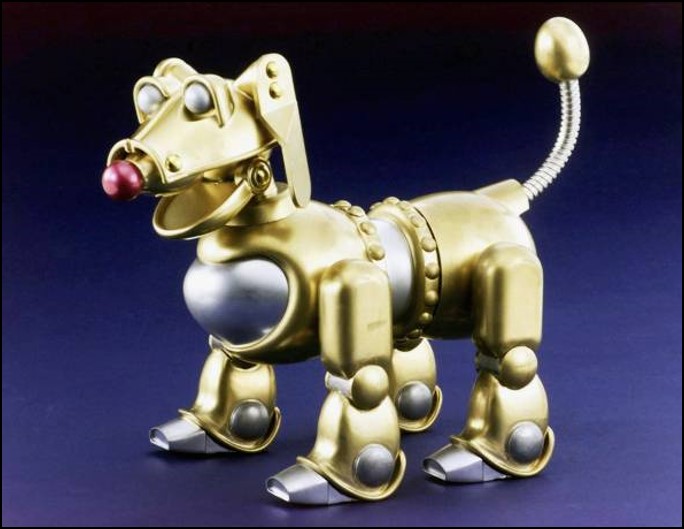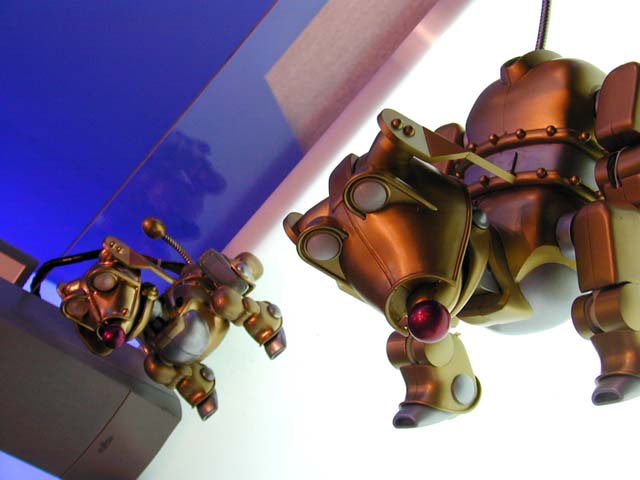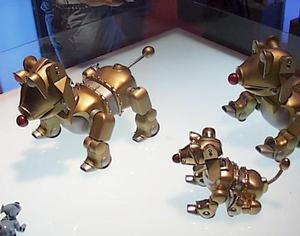This page is incomplete (need to add more info and images and change the way some things are worded).
Dog.com
Dog.com (ドッグ.コム according to the Japanese release or Chien.com according to the Canadian box) is an interactive robot dog from TOMY, released in 2000. While I don't know the release date and RRP for the U.S. and France, Dog.com was scheduled to be released in Japan on the 30th of November that year for 14,800 yen.
Dog.com was developed with the intent of it being a conversational robot, that at first, will make only dog noises, but eventually start to speak like a human (English, Japanese, or French; depending whether you have a Dog.com corresponding to any of the languages mentioned here). According to the U.S. patent, Dog.com was invented by Shinya Saito, who is also credited in some patents for Nintendo.
The robot was shown at Robodex 2000 and at the Tokyo Toy Show that year.
According to TOMY's website, in terms of lore, it's rumored that words from emails on a computer, that was used for development, were transferred to Dog.com.
Appearance
Dog.com is a robot dog with a round translucent red nose, an elliptial pair of ears, a silver tail, a gray neck, and a silver chest area with a heart-shaped area that has speaker holes. The dog has silver feet, and an area of the dog's body, between the dog's front legs and the back legs, is silver.
While Dog.com was sold in a shiny pale blue colorway, Dog.com was also sold in "Platinum White", exclusively in Japan. For this colorway, the blue parts of the dog are white.
History (Prototypes & Target Audience)
Target Audience
Dog.com's target demographic in Japan was women in their 20s and elementary school kids old enough to ask their parents for it. From interviews by Osamu Kirisako, who worked at TOMY, they found that the maximum amount people would be willing to spend on something valuable, such as a mobile phone, would be 20,000 yen. TOMY considered releasing Dog.com for 15,000 yen, as a result, but they chose 14,800 yen as the retail price. According to an interview, TOMY did not price Dog.com for less than 10,000 yen, due to how advanced Dog.com is, and TOMY did not want to remove features that Dog.com was already given to have it priced for less than 10,000 yen.
Color
Dog.com's initial color was gold, and it was referred to as "Human Dog". TOMY then decided to make their robot dog pink, due to how Momo from So-net was popular around the time. When they produced Dog.com in pink, Dog.com looked like a bald dog (I wish TOMY shared a photo of it).
Apparently, a blue prototype displayed in July 2000 at a tradee event was pink initially, so there may not be a pink prototype Dog.com out there.
There were plenty of female employees who worked on Dog.com. From listening to opinions by females, males on the development team learned that girls intentionally dislike pink once they reach middle school age, and apparently, this is done to show they aren't a child. This is why Dog.com is blue.
Additionally, at the Tokyo Toy Show in 2000, visitors asked why Human Dog was gold.
When Kirisako was questioned in the July 2000 interview what colorways Dog.com would be available in, he stated at the time no colorways had been planned yet. However, on the 24th of February, 2001, the Platinum White version of Dog.com was scheduled for release, exclusively in Japan.
Human Dog
"Human Dog" was Dog.com's original name. Dog.com is a streamlined version of Human Dog with a reduced amount of joints and motors.
Three prototypes for Human Dog, plus a smaller version of it, are known to exist. I had a bit of trouble trying to describe this dog's appearance, but I tried.
Prototype 1

Human Dog's eyes are white, its head, body, and legs are gold, and its nose is a dark shade of red. Its nose is opaque and doesn't look like it's supposed to light up. It has a silver chest area, and near each foot, on the left side of each leg, is a silver circle.
Human Dog's feet and tail are silver, but the tip of its tail is gold. The area between the upper and lower half of the dog is silver. The start and end of this silver area has two large gold rings with circular bumps. Its face has a raised, circular bump near its snout on one side, and two raised circular bumps on its ears (there's only one photo of this prototype showing one side of it, but I'd guess these bumps appear on the other side of the dog, too).
Unlike Dog.com, this and the other Human Dog prototypes known to exist have an empty gap between both their eyes. There is no empty gap between the arches for Dog.com's eyes.
I don't know if this is simply a mockup that isn't functional.
Prototype 2


This prototype has the same look as prototype 1, but with some differences. The bolt/screw which hinges the jaw has a silver circular cap, and the head is attached to the body differently. For prototype 1, there is a circular gold plate, to which the head is attached. For prototype 2, the head is attached to the body by what appears to be a rectangular white/silver piece. I don't know if it moves its neck the same way Dog.com does, or if the neck is supposed to have something that can allow it to bend. I haven't seen video footage of Human Dog.
Prototype 2 is also missing a circular bump near its nose, and this prototype's body is more blocky and less round, in contrast to prototype 1. The silver patch on its chest is almost the same shape as the chest area.
Only 2 units of this prototype are known to exist. The two prototypes and Human Dog Baby were shown at the 2000 Tokyo Toy Fair.
Prototype 3

Dog.com & Human Dog at Robodex2000
This prototype is a lot like prototype 2, except, its chest has a few small holes. It was on display at Robodex2000.
Human Dog Baby
Human Dog Baby looks a lot like a miniature version of prototype 2. It has a small circular bump near its nose, like prototype 1. Only 1 unit is known to exist.
Functions
Human Dog is capable of speaking actual words like a human in Kansai dialect. An ASCII article states Human Dog speaks in an old man's voice, and has a vocabulary of approximately 20,000 recorded words. Human Dog was created to communicate with its owner, and to use more of its vocabulary the more you and Human Dog get along. Unlike Dog.com, Human Dog expresses itself by lighting up its eyes. Human Dog Baby can't talk as much as its fully-grown version, but it can communicate with its older version.
Human Dog has 17 motors and sensors such as a light sensor, sound sensor, contact sensor, touch sensor, and tilt sensor.
Prototype Box Art

A box with photos of Human Dog's head, taken from different angles, exists. However, the box also says "Dog.com" on it, and appears to have 2D art of a Dog.com as well.
Blue Prototypes
Functions
Movements
Dog.com can wag his tail, sit or stand, open and close his eyes, raise or lower his head, turn his head left or right, and move his mouth when speaking. While moving his mouth, his nose pokes in and out.
Stages & Personalities
In Dog.com's first stage, he will only make dog sounds at first. In stage two, he will slowly start talking like a human, but by stage 3, he will only talk instead of barking. According to the English manual, Dog.com will speak more than 700 English phrases, and according to a Japanese article and the box for French Dog.coms, Dog.com speaks 795 phrases in total.
Dog.com has multiple personalities, and he will switch to a personality, depending on how you treat him. With certain personalities, Dog.com doesn't move as much.
While the Japanese and English versions have 16 personalities, according to their official documentation, some French commercials and the French Dog.com box claim Dog.com has 18 personalities.
Sensors
Dog.com reacts if you press his nose, rub his chin, pet his head, block his light sensor, place him on his side (tilt sensor), call him, and stroke his back. He also reacts when he doesn't receive any attention from you.
Personalities
The English version has the following personalities:
- Lost Puppy
- Outrageous
- Grouch
- Afraid
- Philosophical
- Joker
- Advice
- Whinny
- Show Time
- Tough
- Space Alien
- Mushey
- Flirt
- Know It All
- Silly
- Insulting
Some Personality Phrases (English)
These lines were copied from the box. These aren't all of Dog.com's lines.
Lost Puppy
- Can I be your friend?
- I wish you'd cuddle me.
- Please take me home.
- Are you my mommy?
- Will you shout at me if I'm bad?
- Please don't forget about me.
Outrageous
- You've got to be kidding!
- If you obey all the rules, you miss all the fun!
- Knock it off, dude!
- Never fear! Dog.com is here!
- Wasssuuupp?
Joker
- I'll bite you.
- Eeaaaarrrtthhhh Quuuaaaaaaaakkee!
- How do you keep a fool waiting? I'll tell you later.
- Dog.com has now been reset... ha ha, just kidding.
Afraid
- Did you hear that creepy sound?
- I feel spooked.
- Don't leave me alone tonight.
- Do you believe in ghosts?
Philosophical
- Every drop of rain adds to the ocean.
- Is your world round?
- Laughter is the best medicine.
- Keep an open mind.
- It's your lucky day!
- The cool thing about robot dogs is they don't smell.
Grouch
- Yeah...whatever.
- I'm not listening.
- Mean dogs have mean owners.
- Talk to the paw!
- Aaagghhh! Stop annoying me.
Advice
- Don't wear it if it itches.
- Always try at least one bite.
- Always knock first.
- Every flower smells a little different.
- Only pick your nose in private.
Whinny
- Can't you be funny?
- I'm getting a headache.
- Don't you like me?
- I'm hungry.
- I'm bored {yawn}.
- Kitty litter is a nightmare, don't you agree?
Show Time
- Go ahead, make my day!
- We're not in Kansas anymore, Dorothy.
- I'm not scared of Cruella.
- Groooovy, baby.
- Use the force.
- I'm not worthy.
- Yeah, baby.
Tough
- I work out, you know.
- Get out of my face.
- Don't push me, man.
- Ease off, buddy.
- I'll deal with you later!
- ...talkin' to me?
Space Alien
- On my planet, humans are like cats.
- Dog.com reporting, sir!
- Alien life forms detected!
- You're my master.
- Earth is boring.
- I boldly go where no dog has gone before.
Mushey
- I'm hooked on you!
- I hope I'm always your favorite toy.
- I love you.
- Let's play.
- That tickles!
- You deserve a big sloppy kiss.
Flirt
- Looking goooood!
- You smell nice.
- Wow, you're hot!
- You're the sweetest friend I have.
- You have such a beautiful voice!
Know it all
- My I.Q. is above average.
- Do you know it would take 20 years to fly to the sun in a jumbo jet?
- I amaze myself with my cleverness.
- Whoever invented dogfood wasn't a dog.
Silly
- I'm soooo dizzy!
- I think I'm going bonkers!
- Yeeeehaaaa!
- You drive me craaaazzzzyy!
- Let's party!
- Where oh where has my little dog gone?
Insulting
- You smell.
- Booooorrrrrrrriiiiiiinnnnggg.
- Pea brain.
- ...Like I care.
- You're creepy.
- (burp)..Sorry does that offend you?
Gallery
Page 28 of "Le Monde" (December 14, 2001)
Dog.com Wearing Different Outfits (From TOMY's Japanese Website)
CGI Dog.com Images
Illustrations from TOMY's website
Canadian Packaging
Japanese Box & Accessories
Trivia
- Houko Kuwashima voiced the Japanese version of Dog.com.
- An agency called Vox For Kids was involved with the voice acting for Dog.com. It's unknown if this was only for the French version.
- Oddly, a French 01net.com news article mentions Dog.com would only be marketed in Japan, though it was released overseas and has an English commercial and multiple French commercials.
- There are Dog.coms which were sold in Canada that have a round sticker on their box featuring a CGI Dog.com with text that says the toy speaks English.
- TOMY revealed a mockup of Monkey.com (モンキーコム) at the 2001 Tokyo Toy Fair. Monkey.com does not appear to have been released, however.
- In France, Dog.com was a part of Tomy's toyline called "Robonetic". The Robonetic toyline consists of robots by TOMY and by other companies that TOMY simply distributed.
- Dog.com does not come with a remote, because people at TOMY wanted it to seem alive.
- Dog.com uses pre-recorded lines stored in his ROM and not speech synthesis. According to Kirisako, due to how many personalities Dog.com has, and how Dog.com changes personalities according to the way he's treated, using speech synthesis to express the certain intonations when needed would not be possible.
- Dog.com has an 8 bit microprocessor and 16 KB of memory.
- TOMY aimed to sell 50,000 units within the first year of its release.
- According to Dog.com's Japanese website, Dog.com doesn't have a gender since he's a robot, but he will use "boku" or "watakushi" to refer to himself. The website also mentioned there's a possibility Dog.com doesn't know whether he is a boy or a girl.
I used he/him to refer to Dog.com on this page only because the English manual does. - Bootleg Dog.com fans exist.
- There's a bump and go robot rat from the early 2000s which looks inspired by Dog.com. The toy was made by another company and also has an RC version of itself and windup versions.
- TOMY was supposed to release another version of Dog.com in June 2001, called Star Dog.com. It isn't confirmed to have been released. It has a different set of personalities and is gold.
- At Robodex 2000, there were Dog.coms which wore translucent pink collars. It's not confirmed if the collars were commercially sold.
Videos
Links
- Lemonde article
- JP scheduled release date mention
- Tomy Interview
- Robodex2000 Cameo (mention of Dog.com being a streamlined version of Human Dog)
- A blogpost of a Dog.com being repaired
- Dog.com press release PDF
- Aucfan listing photos
- Mercari listing photos of a blue Dog.com
Human Dog Info & Images
- PC Watch article featuring prototype 3's photo (it's the source for the pic)
- An ASCII article on Dog.Com's name and appearance change (source for the box photo)
- Robope's website (the second photo of Human Dog on this page came from here)
- Source for the first photo on this page — A rare photo too! Never seen another photo of this prototype.
- A PC Watch article featuring a nice photo of Human Dog and the baby version of it
- An ASCII article with two photos of Human Dog (the source for the third photo on this page)

